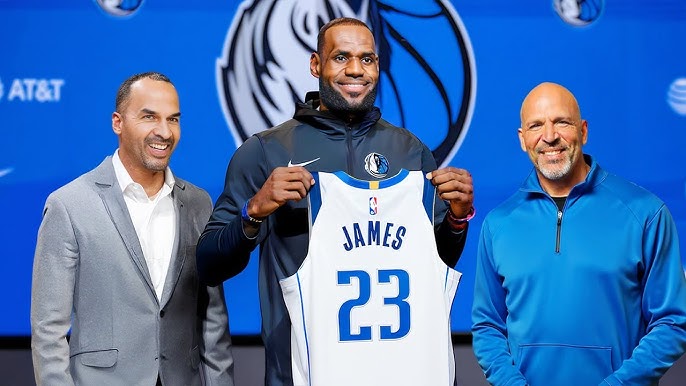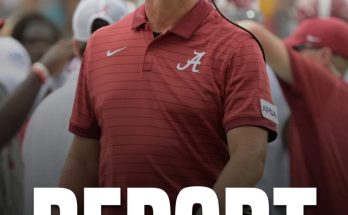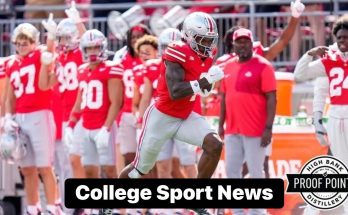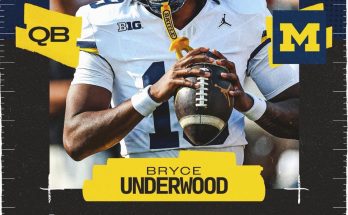In what can only be described as a seismic shift in the NBA landscape, LeBron James has officially been traded to the Dallas Mavericks, forming an electrifying reunion with former teammates Kyrie Irving and Anthony Davis. The blockbuster deal—one of the most dramatic and unexpected in recent memory—instantly reshapes the Western Conference and catapults the Mavericks into title contention, while also raising questions about the future direction of the Los Angeles Lakers. For LeBron, now in the twilight of a legendary career, the move represents not only a strategic basketball decision but also an emotional reconnection with two players who’ve helped define pivotal moments in his NBA legacy.
The trade details emerged after weeks of speculation surrounding the Lakers’ offseason plans and growing frustration over a lack of postseason success despite a star-studded roster. While whispers of LeBron’s potential departure were dismissed as media noise throughout the early summer, insiders began to report an unusual level of tension between James’ camp and Lakers management following yet another disappointing playoff exit. Sources close to the situation indicate that the breaking point came after internal disagreements on roster moves and the team’s refusal to make a big swing in free agency or the trade market. LeBron, whose desire to compete at the highest level has never wavered, reportedly began exploring alternative paths, with the Mavericks quickly emerging as a prime destination.
Dallas, led by owner Mark Cuban and general manager Nico Harrison, wasted no time in pulling the strings on what will go down as one of the most daring trades in franchise history. The Mavericks sent a massive trade package to Los Angeles, including multiple future first-round picks, promising young talent, and key rotation players to make the salaries match. While the Lakers received the depth they’ve long been missing, the Mavericks walked away with arguably the most transcendent player of this generation—alongside two more championship-caliber stars.
What makes this move particularly fascinating is the dynamic among the trio of LeBron James, Kyrie Irving, and Anthony Davis. Each has won an NBA championship with LeBron at the helm—Irving in Cleveland in 2016, and Davis in Los Angeles in 2020. Their chemistry, while tested at times, has proven successful on the game’s biggest stage. Irving and LeBron’s reunion marks the first time they’ve played together since Irving requested a trade from the Cavaliers in 2017, ending a partnership that, though fruitful, was often marked by philosophical differences and internal tension. Now older and seemingly more mature, both men appear ready to write a new chapter together, this time in the heart of Texas.
For Davis, the move to Dallas is surprising but understandable. Despite speculation that the Lakers might try to retain him as a franchise centerpiece post-LeBron, Davis reportedly pushed for inclusion in the trade, favoring a reunion with both LeBron and Kyrie over staying in Los Angeles. Sources indicate that Davis was closely involved in the discussions and welcomed the opportunity to reset in a city with less media scrutiny and an infrastructure better tailored to protect his health and longevity.
On the court, the trio of LeBron, Kyrie, and AD immediately becomes one of the most formidable in the league. LeBron’s all-around brilliance, Kyrie’s offensive wizardry, and Davis’ dominance on both ends provide the Mavericks with a rare combination of skill, IQ, and championship experience. The biggest question will be health—at their respective ages and with varied injury histories, sustaining performance across an 82-game season and a grueling playoff run will require strategic rest, lineup flexibility, and perhaps even load management. But if the trio can stay on the floor, few teams possess the firepower or experience to match them.
The Mavericks’ supporting cast will also be crucial. With Luka Dončić still firmly in place as the face of the franchise, questions loom about how the rotation will evolve. Some insiders believe the Mavericks could deploy LeBron more as a point-forward or even in a small-ball center role to maximize spacing and allow Luka and Kyrie to share ball-handling duties. Others envision a more traditional setup, with Davis anchoring the paint, LeBron facilitating, and Kyrie playing the role of primary shot-creator. However they configure their lineup, the Mavericks now boast an embarrassment of riches on the offensive end.
For Luka Dončić, this move signifies the front office’s commitment to building around him at all costs. While there was concern that acquiring three high-usage stars could diminish Luka’s central role, reports suggest he was informed and consulted throughout the trade process. Luka has long admired LeBron and is said to be excited about the mentorship opportunity and the potential to play meaningful basketball deep into the postseason. The challenge for coach Jason Kidd will be to balance egos, manage playing time, and keep the ball moving in an offense featuring multiple dominant creators.
The implications for the Western Conference are enormous. With Phoenix, Denver, and Minnesota all expected to contend, the addition of LeBron and AD to the Mavericks throws the playoff race into chaos. Dallas, once viewed as a second-tier contender, now demands to be taken seriously as a legitimate title favorite. This move doesn’t just add talent—it brings championship DNA, playoff experience, and an aura that few franchises can replicate. For a team that hasn’t advanced past the conference finals since 2011, this is a statement of ambition and intent.
For the Lakers, this trade marks the end of an era. LeBron James brought a title back to Los Angeles in 2020 during the bubble season, silencing critics and cementing his legacy as a transformative figure for one of basketball’s most storied franchises. His partnership with Davis brought moments of brilliance, but it was often undercut by injuries, lackluster depth, and questionable roster construction. With both stars now gone, the Lakers are poised for a rebuild centered around younger talent and future draft assets. While painful in the short term, the move offers them long-term flexibility and a fresh start under new leadership.
Beyond the Xs and Os, this trade resonates because of the narrative arcs it connects. LeBron and Kyrie’s relationship, once frayed and seemingly irreparable, now gets a second act. Davis, who once forced his way out of New Orleans to join LeBron in L.A., now follows him again, driven by trust and a belief in what they can still accomplish together. The Mavericks, once champions under Dirk Nowitzki, now step into a new golden era with a roster that could dominate the NBA conversation for years to come.
LeBron’s arrival in Dallas also carries major off-the-court implications. From ticket sales to jersey revenue to national media coverage, the Mavericks are about to experience a level of spotlight they’ve never known. With LeBron’s presence comes a wave of attention that will ripple through the NBA, sports media, and popular culture. For a franchise that has often operated on the margins of superstardom despite a loyal fan base and a charismatic owner, this is the moment they’ve long dreamed of.
As for LeBron himself, this may well be his final chapter. At 40 years old, with every accolade imaginable already on his résumé, he’s no longer chasing validation—he’s chasing history. Another championship would give him five, tying him with Kobe Bryant and just one behind Michael Jordan. Doing it alongside Irving and Davis, in a third different franchise, would further elevate his already unparalleled legacy. For LeBron, this isn’t just about winning—it’s about doing so in a way that cements his narrative as the most adaptive, resilient, and impactful player the sport has ever seen.



